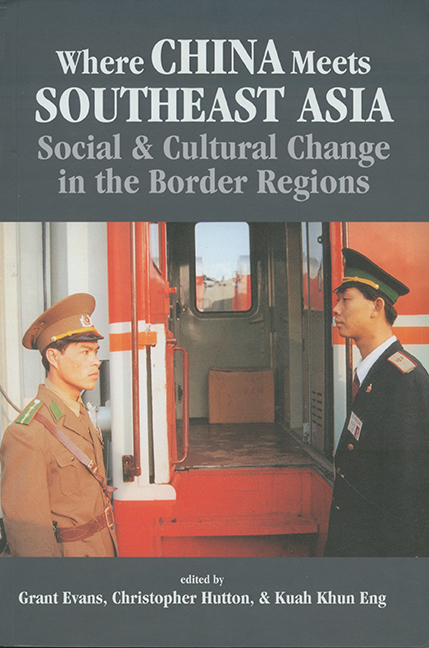Book contents
- Frontmatter
- Contents
- Contributors
- Map
- Introduction: The Disappearing Frontier?
- 1 Where Nothing Is as It Seems: Between Southeast China and Mainland Southeast Asia in the “Post-Socialist” Era
- 2 The Southern Chinese Borders in History
- 3 Ecology Without Borders
- 4 Negotiating Central, Provincial, and County Policies: Border Trading in South China
- 5 The Hmong of the Southeast Asia Massif: Their Recent History of Migration
- 6 Regional Trade in Northwestern Laos: An Initial Assessment of the Economic Quadrangle
- 7 Lue across Borders: Pilgrimage and the Muang Sing Reliquary in Northern Laos
- 8 Transformation of Jinghong, Xishuangbanna, PRC
- 9 The Hell of Good Intentions: Some Preliminary Thoughts on Opium in the Political Ecology of the Trade in Girls and Women
- 10 Cross-Border Mobility and Social Networks: Akha Caravan Traders
- 11 Cross-Border Links between Muslims in Yunnan and Northern Thailand: Identity and Economic Networks
- 12 Trade Activities of the Hoa along the Sino-Vietnamese Border
- 13 Cross-Border Categories: Ethnic Chinese and the Sino-Vietnamese Border at Mong Cai
- 14 Regional Development and Cross-Border Cultural Linkage: The Case of a Vietnamese Community in Guangxi, China
- 15 Women and Social Change along the Vietnam-Guangxi Border
- Index
5 - The Hmong of the Southeast Asia Massif: Their Recent History of Migration
Published online by Cambridge University Press: 21 October 2015
- Frontmatter
- Contents
- Contributors
- Map
- Introduction: The Disappearing Frontier?
- 1 Where Nothing Is as It Seems: Between Southeast China and Mainland Southeast Asia in the “Post-Socialist” Era
- 2 The Southern Chinese Borders in History
- 3 Ecology Without Borders
- 4 Negotiating Central, Provincial, and County Policies: Border Trading in South China
- 5 The Hmong of the Southeast Asia Massif: Their Recent History of Migration
- 6 Regional Trade in Northwestern Laos: An Initial Assessment of the Economic Quadrangle
- 7 Lue across Borders: Pilgrimage and the Muang Sing Reliquary in Northern Laos
- 8 Transformation of Jinghong, Xishuangbanna, PRC
- 9 The Hell of Good Intentions: Some Preliminary Thoughts on Opium in the Political Ecology of the Trade in Girls and Women
- 10 Cross-Border Mobility and Social Networks: Akha Caravan Traders
- 11 Cross-Border Links between Muslims in Yunnan and Northern Thailand: Identity and Economic Networks
- 12 Trade Activities of the Hoa along the Sino-Vietnamese Border
- 13 Cross-Border Categories: Ethnic Chinese and the Sino-Vietnamese Border at Mong Cai
- 14 Regional Development and Cross-Border Cultural Linkage: The Case of a Vietnamese Community in Guangxi, China
- 15 Women and Social Change along the Vietnam-Guangxi Border
- Index
Summary
Over the centuries, the Hmong people have attracted the interest of Asian and Western observers — in particular that of the Han Chinese, the English missionaries in southwest China, and the French colonials in Indochina. It was, however, only after World War II that international interest in the Hmong of Southeast Asia began to intensify, particularly during the Indochina Wars of 1946–54 and 1963–75. American intelligence services produced or commissioned ethnographic studies on highland populations in Laos, Thailand, and both parts of Vietnam, and the Hmong were the subject of several of these studies.
In the 1990s, after the period of political seclusion that followed the communist take-overs in Vietnam and Laos in 1975, the minority regions were rapidly being re-opened, and this could also soon happen in southern China. The possibilities today of doing field research will surely contribute significant additions to the information that has existed ever since the mid-1970s or, in the case of northern Vietnam, for more than five decades. With the present pace of modernization and acculturation of highland societies, along with the forced sedentarization process taking place over the last few years, the task of collecting information is urgent. This chapter provides an account of the migration of the Hmong from China into peninsular Southeast Asia — a critical moment in their history.
WHO ARE THE HMONG?
The ancient history of the Hmong is intimately linked to that of today's Miao of southern China. It is, however, quite another story to pretend that the earlier history of the Hmong is linked also to that of the historical “Miao” as they appear in ancient Chinese texts. The Chinese term Miao was for a long time used in a broadly generic sense and referred to many non-Han ethnic minority groups. In much the same way, no definitive conclusions can be made to ascertain the real identity of the groups called Miao by the earliest Western writers.
- Type
- Chapter
- Information
- Where China Meets Southeast AsiaSocial and Cultural Change in the Border Regions, pp. 98 - 121Publisher: ISEAS–Yusof Ishak InstitutePrint publication year: 2000



